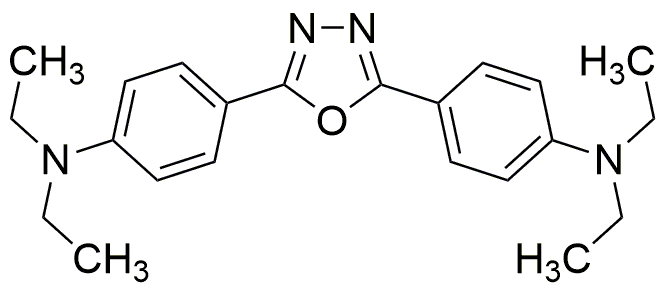2,5-Bis(4-diethylaminophenyl)-1,3,4-oxadiazole is widely utilized in research focused on:
- Fluorescent Dyes: This compound is used as a fluorescent dye in biological imaging, allowing researchers to visualize cellular processes with high sensitivity and specificity.
- Organic Light Emitting Diodes (OLEDs): It serves as a key material in OLED technology, enhancing the efficiency and brightness of displays in consumer electronics.
- Photovoltaic Cells: The compound is applied in the development of organic photovoltaic cells, contributing to renewable energy solutions by improving light absorption and conversion efficiency.
- Sensor Technology: It is utilized in the fabrication of chemical sensors, providing rapid detection of various analytes, which is crucial in environmental monitoring and safety applications.
- Anticancer Research: This chemical has shown potential in anticancer studies, where it is being explored for its ability to selectively target cancer cells, offering a promising avenue for therapeutic development.
General Information
Properties
Safety and Regulations
Applications
2,5-Bis(4-diethylaminophenyl)-1,3,4-oxadiazole is widely utilized in research focused on:
- Fluorescent Dyes: This compound is used as a fluorescent dye in biological imaging, allowing researchers to visualize cellular processes with high sensitivity and specificity.
- Organic Light Emitting Diodes (OLEDs): It serves as a key material in OLED technology, enhancing the efficiency and brightness of displays in consumer electronics.
- Photovoltaic Cells: The compound is applied in the development of organic photovoltaic cells, contributing to renewable energy solutions by improving light absorption and conversion efficiency.
- Sensor Technology: It is utilized in the fabrication of chemical sensors, providing rapid detection of various analytes, which is crucial in environmental monitoring and safety applications.
- Anticancer Research: This chemical has shown potential in anticancer studies, where it is being explored for its ability to selectively target cancer cells, offering a promising avenue for therapeutic development.
Documents
Safety Data Sheets (SDS)
The SDS provides comprehensive safety information on handling, storage, and disposal of the product.
Product Specification (PS)
The PS provides a comprehensive breakdown of the product’s properties, including chemical composition, physical state, purity, and storage requirements. It also details acceptable quality ranges and the product's intended applications.
Certificates of Analysis (COA)
Search for Certificates of Analysis (COA) by entering the products Lot Number. Lot and Batch Numbers can be found on a product’s label following the words ‘Lot’ or ‘Batch’.
Número de catálogo
Número de lote/lote
Certificates Of Origin (COO)
This COO confirms the country where the product was manufactured, and also details the materials and components used in it and whether it is derived from natural, synthetic, or other specific sources. This certificate may be required for customs, trade, and regulatory compliance.
Número de catálogo
Número de lote/lote
Safety Data Sheets (SDS)
The SDS provides comprehensive safety information on handling, storage, and disposal of the product.
DownloadProduct Specification (PS)
The PS provides a comprehensive breakdown of the product’s properties, including chemical composition, physical state, purity, and storage requirements. It also details acceptable quality ranges and the product's intended applications.
DownloadCertificates of Analysis (COA)
Search for Certificates of Analysis (COA) by entering the products Lot Number. Lot and Batch Numbers can be found on a product’s label following the words ‘Lot’ or ‘Batch’.
Número de catálogo
Número de lote/lote
Certificates Of Origin (COO)
This COO confirms the country where the product was manufactured, and also details the materials and components used in it and whether it is derived from natural, synthetic, or other specific sources. This certificate may be required for customs, trade, and regulatory compliance.

